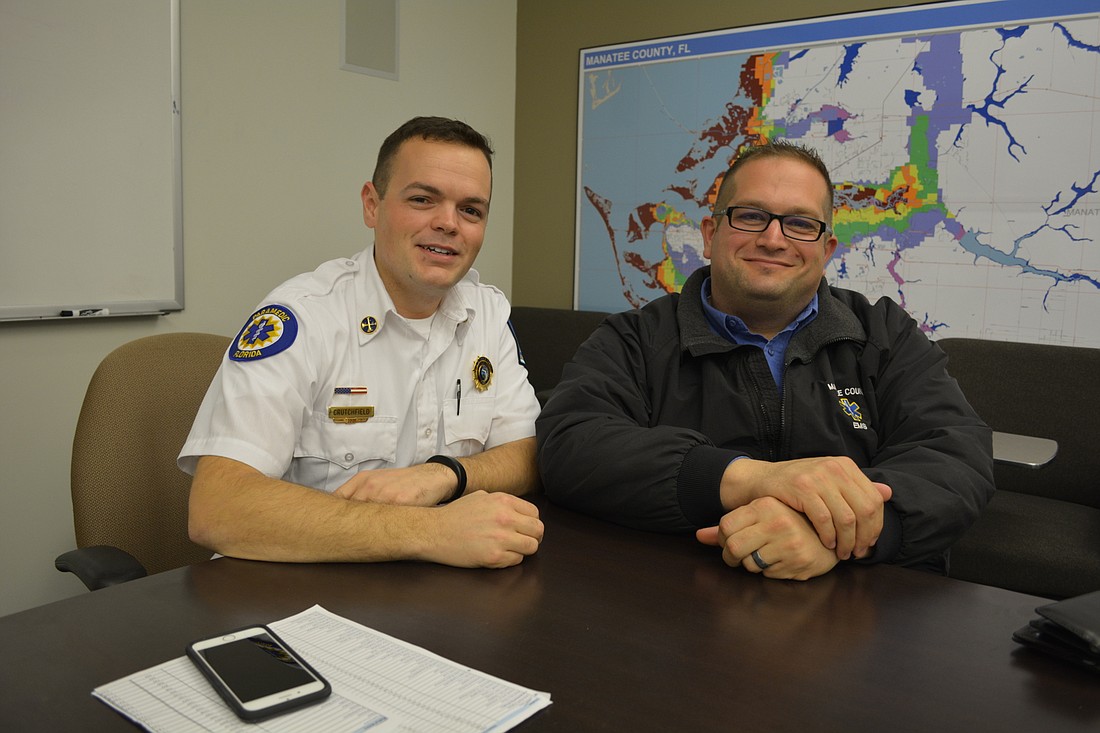- April 17, 2024
-
-
Loading

Loading

Two county paramedics hope they have the answer to a large percentage of unnecessary emergency room visits and 9-1-1 calls.
Jimmy Crutchfield and Paul Dicicco are pushing community paramedicine as a way to relieve stress on the county's medical system.
Nationally, the concept has many names and formats — social medicine, integrated healthcare and advanced practice paramedicine, to name a few — but the idea remains the same.
“In Florida, we’ve been challenged because legislation prohibits an ambulance from transporting a patient to another location besides the emergency room,” said Dicicco, deputy chief of clinical affairs for Manatee County Emergency Medical Services.
He noted some EMS responses are simply to help an individual off the floor or respond to a toothache. “What do you do about that?” Dicicco said.
He and Crutchfield, the interim community paramedic program manager, propose a program in which specially trained paramedics would be allowed to visit the homes of individuals who utilize the 911 call system three times in one month or more to check the home for safety, help a patient take medicines correctly, or address other needs.
For example, if an individual falls numerous times, the community paramedic could evaluate the home for improved safety. Are there hand grips in the bathtub? Could area rugs be causing the individual to trip?
If a diabetic is transported to the emergency room and then sent home with instructions to “eat healthy,” do they even have food?
“This is doing healthcare right,” Crutchfield said. “It allows the patient to become empowered in their own healthcare.”
Dicicco said, “In this case, it’s more of a preventative service. We’re going to prevent a future fall that could prevent a future transport. The physicians don’t see them in their home environment.”
Manatee County EMS has secured funding for the pilot program with a grant (about $250,000 of a larger $860,000 grant with co-recipients Manatee County Health Department and Manatee Memorial Hospital) through June 30 to pay for vehicles, training and other program equipment. EMS has earmarked county dollars to fund the remainder of the fiscal year. Crutchfield and Dicicco are scheduled to present their idea to the Manatee County Commission Feb. 16 because they hope the board will include the program in the Fiscal Year 2017 budget.
Manatee’s proposed Community Paramedic program would target five groups, those who suffer falls or those who have respiratory problems, congestive heart failure, diabetes or mental health/substance abuse.
There will be two new positions for community paramedic, as well as a program manager. The community paramedics will receive special training.
An annual survey of EMS calls will help guide the program’s focus.
Crutchfield and Dicicco said the financial impact could be huge, helping the county deal with an overall funding issue for indigent health care. Manatee County has depleted a trust from the sale of Manatee Memorial Hospital, which it historically used to pay about $10 million in indigent healthcare annually.
To put the figures in perspective, on Jan. 26, the Manatee County Commission agreed to write off $517,736.78 in uncollectible EMS ambulance user fees, just for the month of November 2015. Manatee County EMS has a collection rate of 67%, which exceeds industry standards of between 35% and 45%.
The majority of uncollected charges involve patients who cannot pay for service, patients who provide an unverifiable billing address, patients who have moved and left no forwarding address, patients who have a large insurance deductible they cannot pay and patients who fail to meet their co-pay requirements.
Such patients, Crutchfield and Dicicco said, are the target of the program.
They also believe the county is resource rich in terms of services available to patients. The problem is that the programs don’t intermingle. This program will help resolve that problem.
“Everyone is operating in their own little kingdom and it’s costing so much money,” Crutchfield said.
Crutchfield said other community paramedic programs across the country, such as Medstar in Texas, are realizing better patient outcomes and saving money for medical providers and governments alike.
Manatee’s EMS division chief, Stephen Krivjanik, supports the efforts for that reason.
“I think this is going to have such a significant impact,” he said. “The folks who over-utilize the system will have hands-on, in-home intervention.”